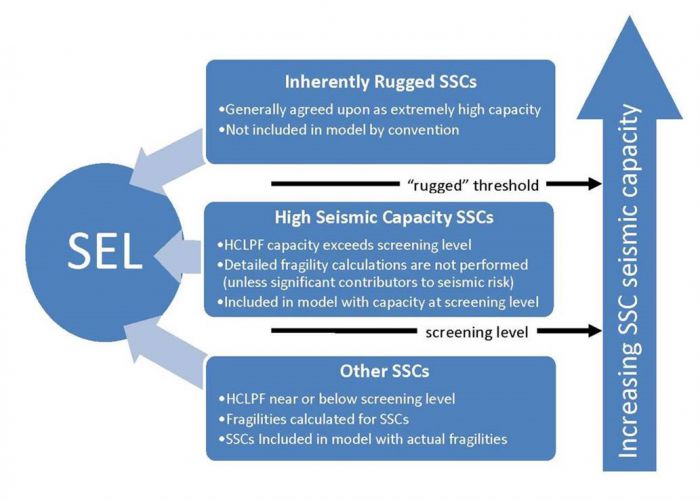Seismic Equipment List Screening (Task 8)
Task Overview
Objective
The objective is to screen components from the SEL for prioritization of performing plant-specific seismic fragility calculations of SSCs.
Purpose
This section describes a process for developing screening guidelines for the SEL to support development of an SPRA. The SEL screening guideline supports the prioritization of performing plant-specific seismic fragility calculations of SSCs.
Guidance
Screening of items on the SEL is illustrated in Figure 8-1 below.
A common approach for screening the SEL includes the following general steps:
- Screen inherently rugged SSCs. Inherently rugged SSCs typically include:
- Manual valves
- Motor operated valves
- Air-operated valves
- Check valves
- Strainers
- Specific piping
- Assign initial, representative fragility values for SSCs.
- Often median fragilities on the lower end of the representative ranges are considered when selecting a representative value for the purposes of screening components on the SEL.
- For buildings and major structures, median fragilities on the higher end of the representative ranges are typically considered so that catastrophic failures that with significant consequences do not mask the risk impacts of other SSCs on the SEL.
- Refer to EPRI 3002000709 Appendix H for ranges of representative fragilities and EPRI 3002012994 Section 6.2.3 for supplemental guidance.
- Create and quantify an initial SPRA model.
- The initial SPRA model is created as described in Safety Systems and Internal Events PRA (Task 1) from the FPIE model or by considering the scope of potential seismic induced failures and systems necessary to respond to those accidents. The initial SPRA model uses the initial representative fragilities, and other initial SPRA model assumptions such as relay chatter (Relay Chatter Evaluation (Task 9)), correlation assumptions and initial SPRA human error probabilities (HEPs) (Seismic Human Reliability Analysis (Task 12)).
- Quantify the model using the plant specific seismic hazard input (Seismic Risk Quantification (Task 13)).
- Rank the SSCs by importance measure
- SSC importance is typically performed using importance measure such as Fussell-Vesely (FV) or Birnbaum for CDF or LERF.
- Perform detailed fragility calculations for the risk-important SSCs.
- The most risk-important SSCs typically have site-specific fragility evaluations rather than representative fragilities (Seismic Fragility Calculations (Task 10)).
- As fragility calculations are refined, the updated fragility data can be incorporated back into the initial SPRA model to recalculate the results. The importance measures can be reviewed again to reevaluate the prioritization for performing additional detailed fragility calculations.
- This refinement process is typically repeated until a satisfactory model is developed.
- Document the SEL screening process.
- Detailed documentation for each step of the SEL screening and prioritization process for fragility calculations, including all assumptions supporting the SEL screening process is typically provided.
Supplemental Guidance
Related Element of ASME/PRA Standard
Part 5, Seismic Fragility-Response (SFR)
Part 5, Seismic Plant-Response (SPR)
EPRI Guidance
Seismic Probabilistic Risk Assessment Implementation Guide (3002000709) provides example guidance and suggests a screening criterion of 1E-7 per year as a starting point for the analysis. Appendix E provides a sample SEL.
Seismic Fragility and Seismic Margin Guidance for Seismic Probabilistic Risk Assessments (3002012994) Section 6.2 provide guidance on seismic capacity related screening.
Screening, Seismic Evaluation Guidance: Screening, Prioritization and Implementation Details (SPID) for the Resolution of Fukushima Near-Term Task Force Recommendation 2.1: Seismic (1025287), Section 6.4.3.
Other Guidance
IAEA Safety Guide SSG-3, “Development and Application of Level 1 Probabilistic Safety Assessment for Nuclear Power Plants” provides a general description of SEL screening.
